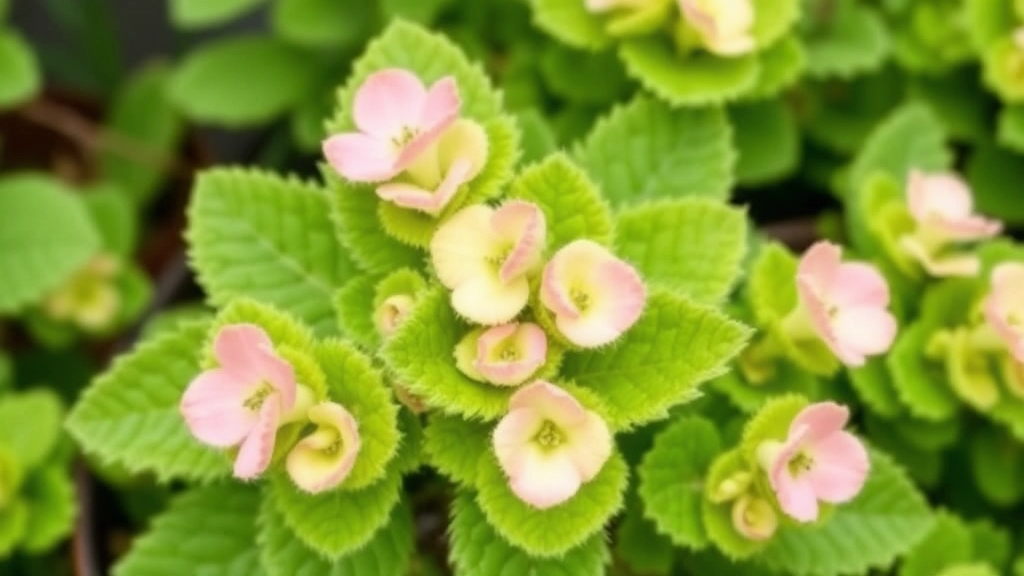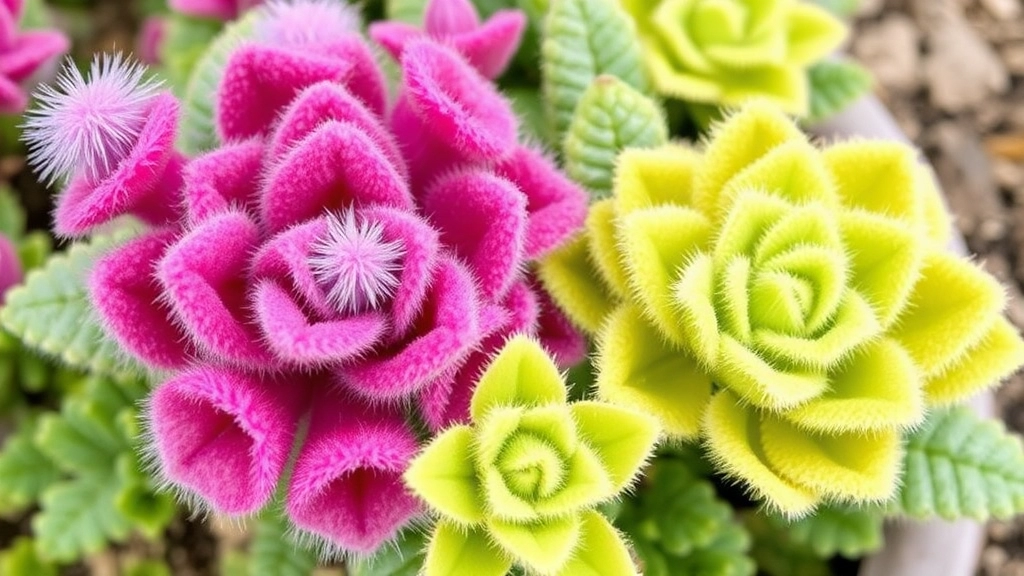Fuzzy Kalanchoe Types
When it comes to fuzzy Kalanchoe types, I can’t help but get excited about the variety and charm these plants bring to any space. From their soft, velvety leaves to their diverse shapes and sizes, these succulents are a joy to grow and admire. Whether you’re a seasoned plant enthusiast or just starting out, there’s something special about the tactile experience of handling these fuzzy beauties.
Exploring the different fuzzy Kalanchoe types can be a fun and rewarding journey. Each type has its own unique characteristics, making them perfect for adding a touch of nature to your home decor. Plus, they’re relatively low-maintenance, which is always a bonus. So, if you’re looking to expand your plant collection or simply want to learn more about these fascinating succulents, you’re in the right place.
Overview of Fuzzy Kalanchoe Varieties
When considering adding a touch of greenery to your space, fuzzy Kalanchoe varieties might just be what you’re looking for.
These unique plants, belonging to the succulent family, are not only visually appealing but also relatively easy to care for.
Fuzzy Kalanchoes, known for their soft, velvety leaves, come in several species, each offering its own charm and characteristics.
Unique Features of Fuzzy Kalanchoe
- Leaf Texture: The standout feature of fuzzy Kalanchoes is their fuzzy, often hairy leaves, which can vary in colour from deep green to silvery hues.
- Flowering: Many species produce vibrant flowers, adding a splash of colour to their lush foliage.
- Size Variations: Depending on the species, these plants can range from compact varieties perfect for small spaces to larger types that can serve as striking centrepieces.
Popular Varieties
Some of the most popular fuzzy Kalanchoe species include:
- Kalanchoe tomentosa: Also known as Panda Plant, this variety features thick, fuzzy leaves with a hint of red along the edges.
- Kalanchoe beharensis: Known as Elephant Ear, it has larger, more textured leaves and can grow quite tall.
- Kalanchoe luciae: Commonly referred to as the Paddle Plant, it has stunning, paddle-shaped leaves that can turn a beautiful red in bright sunlight.
Understanding these varieties is essential for choosing the right one for your home or garden. For more detailed care tips, check out our Kalanchoe tomentosa care guide and our Elephant Ear Kalanchoe care guide.
Popular Fuzzy Kalanchoe Species

So, you’re curious about fuzzy Kalanchoe species, huh? You’re not alone! Many plant lovers are drawn to these unique beauties for their charming textures and vibrant colors.
Kalanchoe tomentosa (Panda Plant)
This is probably the most famous fuzzy Kalanchoe out there.
- Features: Its leaves are covered in soft, white hairs, giving them a velvety feel.
- Flowers: When it blooms, you’ll see clusters of bright yellow-orange flowers.
- Why It’s Popular: Easy to care for and visually striking, it’s a favourite for beginners.
Kalanchoe beharensis (Felt Plant)
Another standout in the fuzzy family is the Felt Plant.
- Features: This one sports large, thick leaves that are covered in a soft, greyish fuzz.
- Height: It can grow quite tall, making it a fantastic statement piece.
- Why It’s Popular: Its unique look and minimal care requirements make it a go-to for many.
Kalanchoe luciae (Flapjack Plant)
Now, let’s talk about the Flapjack Plant.
- Features: Its leaves are broad and paddle-like, with a lovely reddish tint on the edges.
- Sunlight: It thrives in bright light, which brings out its stunning colours.
- Why It’s Popular: Its quirky shape and vibrant hues make it a favourite among collectors.
Kalanchoe marnieriana (Chandelier Plant)
Last but not least, we have the Chandelier Plant.
- Features: This species has unique, cylindrical leaves that grow in a rosette pattern.
- Growth Habit: It can trail beautifully, perfect for hanging pots.
- Why It’s Popular: Its unusual appearance and trailing habit make it a hit for indoor gardening.
Growing Conditions for Fuzzy Kalanchoe
When considering the ideal environment for Fuzzy Kalanchoe, many enthusiasts wonder about the best conditions to ensure vibrant growth.
Light Requirements
Fuzzy Kalanchoes thrive in bright, indirect sunlight.
- Optimal Location: A south or east-facing window is ideal.
- Avoid Direct Sunlight: Too much direct sun can scorch the leaves.
Temperature Preferences
Temperature plays a crucial role in the health of your Fuzzy Kalanchoe.
- Ideal Range: They prefer temperatures between 15°C to 25°C.
- Avoid Frost: Protect them from temperatures below 10°C.
Humidity Levels
Humidity levels can significantly impact the growth of Fuzzy Kalanchoe.
- Moderate Humidity: They do well in average household humidity.
- Avoid Excess Moisture: High humidity can lead to rot.
Soil Type
Choosing the right soil can make all the difference.
- Well-Draining Soil: A cactus or succulent mix is best.
- pH Level: Aim for a slightly acidic to neutral pH (6.0 to 7.0).
Watering Needs
Watering is a common concern for many plant owners.
Common Care Tips for Fuzzy Kalanchoe

Caring for your Fuzzy Kalanchoe can seem daunting, but with the right approach, it becomes a rewarding experience. Many enthusiasts worry about maintaining the delicate balance of light, water, and temperature for these charming plants.
Light Requirements
- Bright Indirect Light: Fuzzy Kalanchoes thrive in bright, indirect sunlight.
- Avoid Direct Sun: Too much direct sunlight can scorch their leaves.
Watering Guidelines
- Moderate Watering: Allow the top inch of soil to dry out before watering again.
- Drainage is Key: Ensure your pot has drainage holes to prevent root rot.
Temperature and Humidity
- Ideal Temperature: They prefer temperatures between 15°C and 25°C.
- Humidity Levels: Average household humidity is sufficient; avoid overly humid environments.
Fertilisation
- Balanced Fertiliser: Use a balanced, water-soluble fertiliser during the growing season.
- Frequency: Fertilise every 4-6 weeks for optimal growth.
Pruning and Maintenance
- Remove Dead Leaves: Regularly check for and prune any dead or yellowing leaves.
- Promote Airflow: Space your plants to ensure good airflow, reducing the risk of disease.
Propagation Techniques for Fuzzy Kalanchoe
Are you eager to expand your collection of Fuzzy Kalanchoe? Propagation is a rewarding way to do just that. Whether you’re a seasoned gardener or a beginner, understanding the right techniques can make all the difference.
Methods of Propagation
- Leaf Cuttings
- Select a healthy leaf from your Fuzzy Kalanchoe.
- Allow the cut end to dry for a few hours to form a callus.
- Place the leaf on well-draining soil, keeping it slightly moist.
- In a few weeks, you should see new roots forming.
- Offsets
- Look for small offsets or pups at the base of the parent plant.
- Gently remove them, ensuring they have some roots attached.
- Plant them in their own pots with well-draining soil.
- Water lightly until they establish.
- Stem Cuttings
- Cut a healthy stem, ideally 4-6 inches long.
- Let the cut end dry for a day to encourage rooting.
- Place the cutting in a pot with well-draining soil.
- Water sparingly until roots develop.
Tips for Successful Propagation
- Timing Matters: Spring or early summer is the best time for propagation, as the plant is actively growing.
- Humidity: A humid environment can encourage rooting. Consider covering the cuttings with a plastic bag to maintain moisture.
- Light Requirements: Ensure your cuttings receive bright, indirect sunlight to promote healthy growth.
By employing these propagation techniques, you can easily grow new Fuzzy Kalanchoe plants, enriching your garden or home. For more detailed steps, check out our guide on how to propagate Kalanchoe Mother of Thousands easily and explore our step-by-step instructions for Fuzzy Kalanchoe propagation.
So, you’ve got your fuzzy Kalanchoe and it’s looking a bit under the weather? Don’t worry, you’re not alone!
Many plant parents face issues with these charming succulents. Let’s dive into some common problems and how to fix them.
### 1. Leaves Turning Yellow
– **Overwatering**: This is the most common culprit.
– Check the soil; if it’s soggy, hold off on watering.
– **Underwatering**: Conversely, if the leaves are shrivelling, they might need a drink.
– Aim for a balanceâwater when the top inch of soil feels dry.
### 2. Fuzzy Texture Fading
– **Lack of Sunlight**: Fuzzy Kalanchoes love bright, indirect light.
– If they’re in a dark spot, move them to a sunnier location.
– **Too Much Direct Sun**: On the flip side, direct sunlight can scorch those fuzzy leaves.
– A sheer curtain can help filter harsh rays.
### 3. Dropping Leaves
– **Temperature Shock**: These plants prefer a stable environment.
– Keep them away from drafts and sudden temperature changes.
– **Pests**: Check for tiny bugs or webbing on your plant.
– A gentle wash with soapy water can help get rid of them.
### 4. Stunted Growth
– **Nutrient Deficiency**: If your Kalanchoe isn’t growing, it might be hungry.
– Use a balanced, diluted fertiliser during the growing season.
– **Pot Bound**: If roots are coming out of the drainage holes, it’s time for a bigger pot.
### 5. Root Rot
– **Signs**: A foul smell or mushy roots means trouble.
– Remove the plant from its pot, trim away the rot, and [repot in fresh, dry soil](https://planthq.org/kalanchoe-leaf-problems-causes-solutions-and-prevention/).
– **Preventative Measures**: Ensure your pot has good drainage and avoid overwatering.
For more detailed care instructions, check out our [ultimate guide to caring for Kalanchoe succulents](https://planthq.org/how-to-care-for-kalanchoe-succulent-ultimate-guide/).
FAQs About Fuzzy Kalanchoe Types
What are some popular fuzzy Kalanchoe species?
Popular fuzzy Kalanchoe species include Kalanchoe tomentosa (Panda Plant), Kalanchoe beharensis (Felt Plant), Kalanchoe luciae (Flapjack Plant), and Kalanchoe marnieriana (Chandelier Plant).
What makes Kalanchoe tomentosa (Panda Plant) unique?
The Panda Plant is known for its velvety leaves covered in soft, white hairs and its clusters of bright yellow-orange flowers.
Why is Kalanchoe beharensis (Felt Plant) popular?
The Felt Plant is popular due to its large, thick leaves covered in soft, greyish fuzz and its ability to grow tall, making it an excellent statement piece.
How does Kalanchoe luciae (Flapjack Plant) stand out?
The Flapjack Plant is distinguished by its broad, paddle-like leaves with a reddish tint on the edges, which thrive in bright light.
What are the features of Kalanchoe marnieriana (Chandelier Plant)?
The Chandelier Plant has unique, cylindrical leaves that grow in a rosette pattern and can trail beautifully, making it perfect for hanging pots.
What kind of light do fuzzy Kalanchoes need?
Fuzzy Kalanchoes thrive in bright, indirect sunlight. It’s important to avoid direct sunlight, which can scorch their leaves.
How often should I water my fuzzy Kalanchoe?
Water your fuzzy Kalanchoe moderately, allowing the top inch of soil to dry out before watering again. Ensure your pot has drainage holes to prevent root rot.
What is the ideal temperature for fuzzy Kalanchoes?
Fuzzy Kalanchoes prefer temperatures between 15°C and 25°C. Average household humidity is sufficient, but avoid overly humid environments.
How should I fertilise my fuzzy Kalanchoe?
Use a balanced, water-soluble fertiliser during the growing season, fertilising every 4-6 weeks for optimal growth.
What maintenance do fuzzy Kalanchoes require?
Regularly check for and prune any dead or yellowing leaves to promote healthy growth. Ensure good airflow around your plants to reduce the risk of disease.
References
-
Growing Kalanchoe Tomentosa (Panda Plant)
-
Kalanchoe Beharensis Care
-
Kalanchoe Luciae (Flapjack Plant) Care Guide
